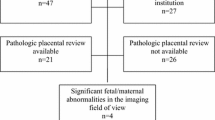Abstract
Background
Antenatal diagnosis of the invasiveness of a placenta percreta helps in planning the surgical approach, reducing blood loss and morbidity. Doppler sonography is the mainstay diagnostic modality with a sensitivity of 80–95 %. With the advent of high magnetic field MRI techniques, there has been recent interest in evaluation of placenta by MRI. On an extensive PUBMED search, we could not find any citations describing imaging, ultrasound, or MRI features to evaluate vesical wall invasion by placenta percreta.
Purpose
We attempt to evaluate transmyometrial vesical wall invasion by placenta percreta using chemical shift artifact as a marker of intact bladder-myometrial interface on steady-state MRI sequences.
Materials and Methods
This is a prospective observational study, conducted at a university hospital. We have compiled clinico-radiological criteria for diagnosis of invasive placentae based on the existing body of evidences, in four patients. We further go on to analyze a specific proposed sign on a newly introduced MR imaging sequence i.e., loss of chemical shift artifact (India ink line) on steady-state GRE sequence (TrueFISP), to diagnose transmyometrial vesical invasion in placenta percreta.
Results
Though the sample size is small, the sensitivity, specificity, positive, and negative predictive value of the proposed sign for the purpose was 100 %.
Conclusions(s)
Loss of chemical shift artifact (India ink line) on steady-state GRE sequences at the vesico-myometrial junction in case of invasive placentae confirms vesical wall invasion, a prospective diagnoses of which can help in planning the surgical protocol and preventing potentially fatal blood loss.




Similar content being viewed by others
References
Zhuo J, Gullapalli RP. MR artifacts, safety, and quality control. Radiographics. 2006;26:275–97.
Bitar R, Leung G, Perng R, et al. MR pulse sequences: what every radiologist wants to know but is afraid to ask. Radiographics. 2006;26:513–37.
Reiser MF. Magnetic resonance tomography. Berlin: Springer Verlag; 2007 ISBN:354029354X.
Hood MN, Ho VB, Smirniotopoulos JG, et al. Chemical shift: the artifact and clinical tool revisited. Radiographics. 1999;19:357–71.
Israel GM, Hindman N, Hecht E, et al. The use of opposed-phase chemical shift MRI in the diagnosis of renal angiomyolipomas. AJR. 2005;184:1868–72.
Chou MM, Ho ESC. Prenatal diagnosis of placenta previa accreta with power amplitude ultrasonic angiography. Am J Obstet Gynecol. 1997;177:1523–5.
Lax A, Prince MR, Mennitt KW, et al. The value of specific MRI features in the evaluation of suspected placental invasion. Magn Reson Imaging. 2007;25:87–93.
Maldjian C, Adam R, Pelosi M, et al. MRI appearance of placenta percreta and placenta accreta. Magn Reson Imaging. 1999;17(7):965–71.
Dwyer BK, Belogolovkin V, Tran L, et al. Prenatal diagnosis of placenta accreta: sonography or magnetic resonance imaging? J Ultrasound Med. 2008;27(9):1275–81.
Masselli G, Brunelli R, Casciani E, et al. Magnetic resonance imaging in the evaluation of placental adhesive disorders: correlation with color Doppler ultrasound. Eur Radiol. 2008;18:1292–9.
Chavhan GB, Babyn PS, Jankharia BG, et al. Steady-state MR imaging sequences: physics, classification, and clinical applications. Radiographics. 2008;28:1147–60.
Monti L, Infante MV, Manias T, et al. India ink artifact on ECG-gated SSFP sequences predicts resectability of tumours invading the mediastinum. J Cardiovasc Magn Reson. 2012;14(Suppl 1):53.
Kim YJ, Hur J, Lee HJ, et al. Lipomatous metaplasia in patients with myocardial infarction: evaluation with cardiac magnetic resonance. J Cardiovasc Magn Reson. 2010;12(Suppl 1):165.
Acknowledgments
None.
Compliance with ethical requirements and Conflict of interest
These studies were performed as per routine clinical referral following standardized technique for gestational MRI. Informed consent from patients were taken and has been already mentioned. No novel intervention mandating ethical clearance over and above the informed consent and clinical referral was hence required. The authors report no conflict of interest.
Author information
Authors and Affiliations
Corresponding author
Rights and permissions
About this article
Cite this article
Kumar, I., Verma, A., Jain, S. et al. Chemical Shift Artifact on Steady-State MRI Sequences for Detection of Vesical Wall Invasion in Placenta Percreta. J Obstet Gynecol India 66, 101–106 (2016). https://doi.org/10.1007/s13224-014-0660-y
Received:
Accepted:
Published:
Issue Date:
DOI: https://doi.org/10.1007/s13224-014-0660-y




